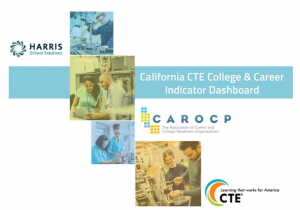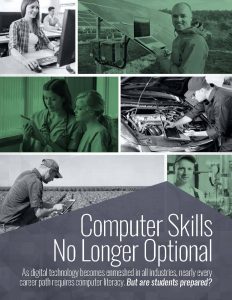Last week, we held the 2017 Advance CTE Spring Meeting, which brought over 200 participants from across the country together to dive into all things CTE. From digging into new research to updates on federal policy, hear what our staff had to say as they reflected on this year’s meeting in this three-part series.
As the topic of career readiness continues to gain prominence in state policy conversations, state and local CTE leaders have been increasingly interested in career advising and counseling as strategies for improving career readiness. In response to that interest, Advance CTE had two sessions at our Spring Meeting on counseling.
The first was our keynote speaker on the second day of the meeting, 2017 School Counselor of the Year, Terri Tchorzynski. Terri, a school counselor at the Calhoun Area Career Center in Battle Creek, Michigan, spoke about how she uses data to plan interventions that support students’ needs not just emotionally, but academically as well. For me, it was informative to hear her discussions on the stigmas and perceptions facing both CTE and counseling, and her superhero examples led to an unofficial theme for the day – describing the people who do this work on the ground in schools as true superheroes.
The second session that day on counseling was a breakout led by Jill Cook, Assistant Director of the American School Counselor Association. In her session, Jill led a discussion with our members on the role counselors can and should play in schools, and how they can support CTE. This information seemed particularly relevant given the report just released on the attitudes of students and parents when it comes to CTE. I’m excited to continue this conversation and find ways for counselors and CTE leaders to work together and help learners.
Ashleigh McFadden, State Policy Manager
At last year’s spring meeting we debuted new candies printed with the brand-new Advance CTE logo. We jokingly referred to these as “Advance-mints” in recognition of the new name.
Candy-related puns aside, advancement was a clear and unspoken theme at the 2017 spring meeting. This year’s conference explored thorny issues, celebrated exemplar programs and continued to advance an ambitious agenda centered around the organization’s Putting Learner Success First vision for the future of CTE.
On Tuesday afternoon, Advance CTE coordinated five concurrent workshop sessions, building on a new idea introduced at the October convening. These sessions were designed to help participants go deep on a particular issue and work through challenges with experts in the field. Each session took a different approach — some included panel discussions, while others required participants to roll up their sleeves and work on material they could take back to their states. But the aim of each session was the same: to inspire deep thinking and idea sharing and advance the caliber of the field.
The topics for the five sessions included:
- Determining Quality Industry-Recognized Credentials
- Driving Continuous Improvement through Meaningful Local Program Evaluation
- Finding the Right Message for Students and Parents
- Input Session: CTE Program Approval Policy Framework
- Using Career Readiness Data to Drive Student Success
I attended “Driving Continuous Improvement,” which was developed and run by Sandra Staklis and Laura Rasmussen Foster at RTI International. Through a technical assistance contract with the Office of Career, Technical and Adult Education (OCTAE), RTI has been working with different states to identify relevant metrics and design rubrics to support monitoring and accountability at the local level. In North Carolina, RTI helped design a CTE program evaluation instrument that local districts have since been using to evaluate the quality and health of their programs. In Wyoming, a similar rubric is being used to facilitate regional conversations, using data to explore continuous improvement opportunities.
In the session, we unpacked trends RTI uncovered in their work, and helped participants explore potential metrics to use in their own states. At my table, we decided to prioritize student success outcomes, pulling out metrics such as the “percentage of CTE students enrolling in postsecondary without requiring remediation” and “percentage of CTE students employed in high wage, high demand fields after graduation.” Although these indicators are often the hardest to measure, they are no less important in determining program success.
Austin Estes, Policy Associate


 year’s graduates to really be ‘college and career ready?’” To answer that question, we first must decide what, exactly, that phrase really means.
year’s graduates to really be ‘college and career ready?’” To answer that question, we first must decide what, exactly, that phrase really means. experience. Practical-skill attainment based on robust CTE Programs of Study can lead to increased student engagement. Industry credentials can be earned before a student graduates from high school.
experience. Practical-skill attainment based on robust CTE Programs of Study can lead to increased student engagement. Industry credentials can be earned before a student graduates from high school. nly happens if we, as CTE educators, commit our time, resources, and energy to ensuring “college and career ready” stands for something more than just words – we must translate it into numbers.
nly happens if we, as CTE educators, commit our time, resources, and energy to ensuring “college and career ready” stands for something more than just words – we must translate it into numbers. to mechanic’s shop, or in a tractor on a farm.
to mechanic’s shop, or in a tractor on a farm. skills in the issue brief that will be included in your Advance CTE Spring Meeting conference bag.
skills in the issue brief that will be included in your Advance CTE Spring Meeting conference bag.
 Join us May 2 – 4, 2017 in Washington, D.C. four our annual Spring Meeting bringing together Career Technical Education (CTE) leaders from across the country for two and a half days of panels, breakout sessions and networking opportunities. This year’s meeting will feature over 25 leaders in CTE tackling issues from Perkins reauthorization to expanding access to CTE in rural communities.
Join us May 2 – 4, 2017 in Washington, D.C. four our annual Spring Meeting bringing together Career Technical Education (CTE) leaders from across the country for two and a half days of panels, breakout sessions and networking opportunities. This year’s meeting will feature over 25 leaders in CTE tackling issues from Perkins reauthorization to expanding access to CTE in rural communities.
